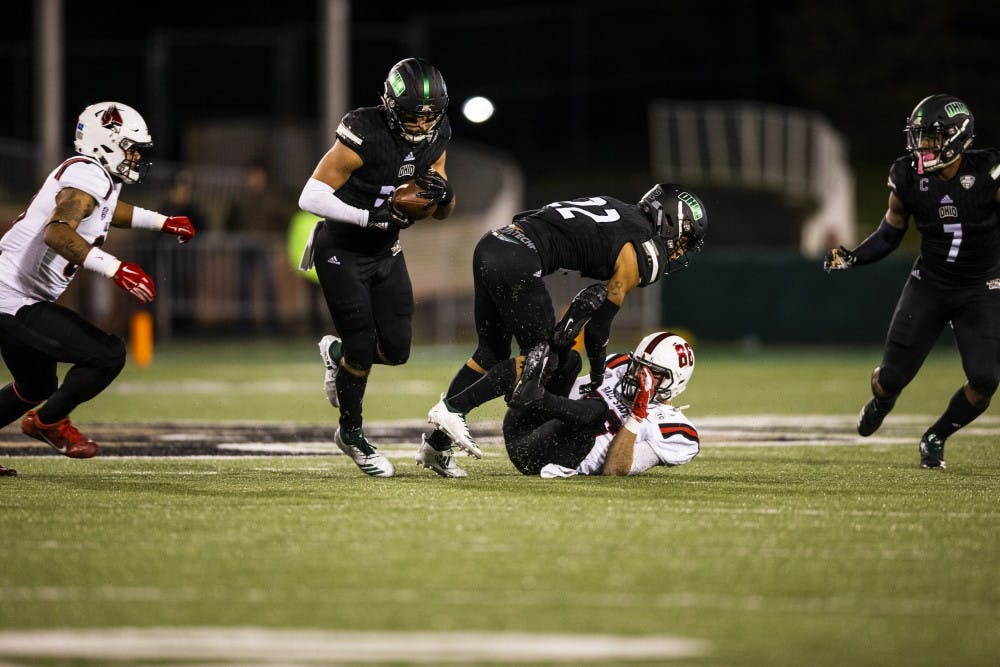Jared Dorsa mentioned it in his post-game interview. Frank Solich echoed it when he sat at the same table a few minutes later and fielded questions.
It didn’t matter who was answering questions, the answer remained the same. Early in the season, Ohio’s defense had some “growing pains” to work through. Blown assignments, missed tackles and poor play paralyzed the Bobcats in the first half of the season.
But on Thursday night, the Bobcats outgrew those pains and dominated for nearly the entire game in their 52-14 win over Ball State at Peden Stadium.
“We did have some growing pains early, but guys have responded in a very positive way,” Solich said. “We’ve gotten better and better as we’ve matured as a defense.”
After six games, the Bobcats were ranked in the bottom 10 nationally for yards allowed per game. They gave up least 400 yards in each of those games, and they were 3-3. Since then, Ohio has allowed 279.5 yards per game.
More importantly, it's 2-0.
Ohio appeared to have a hard time overcoming the loss of nearly its entire defensive line, not to mention Chad Moore and Quentin Poling, two All-MAC caliber players who graduated. But against Bowling Green and Ball State, the Bobcats had their way.
“Beginning of the season, there were obviously a lot of growing pains,” Dorsa said. “Got off to a pretty slow start. But we work really well together as a whole defense. We’re a pretty close group. When it comes to practice time, a lot of the times, we’re really good about correcting each other the right way and really helping each other out. We’re growing together.”
Growth is apparent. Bowling Green didn’t score in the final 43 minutes last week. Ball State scored on its third drive early in the first half — and didn’t score again until its last drive. By that time, the Bobcats had scored 52 unanswered points and put their backups in.
Ball State’s drive chart between its two touchdown drives was nearly made for satire, featuring six punts, an interception and two fumbles.
Ohio’s defense allowed one first down — one — to Ball State during the second and third quarters. The Cardinals didn’t eclipse the 200 total-yard mark until well into the fourth quarter. The Bobcats swarmed around the ball, forced turnovers and made plays, particularly in stopping the run.
“We pride ourselves on being run stoppers,” Dorsa said. “At the beginning of the year, we were struggling in the pass game. We identify as run stoppers, but we realize that our weakness is pass game, so we really have worked on not just being a one-trick pony, working on everything.”
For Dorsa, working on pass coverage paid dividends. In the middle of the third quarter, Ball State quarterback Drew Plitt looked and threw to his left. The pass was tipped by Javon Hagan, and it landed into the hands of Dorsa, who came up with his first career interception.
His was one of three forced turnovers by Ohio. The Bobcats also had six tackles for loss and two sacks. Ball State only had the ball for a little over 21 minutes. Ohio forced seven three-and-outs.
“We’re moving more,” Solich said. “I think that’s really helped us. We’ve got good team speed. We’re utilizing that team speed.”
While Solich is thrilled to see a competent defensive effort in consecutive games, he understands to put games into context. Bowling Green is one of the weakest opponents on Ohio’s schedule. Ball State has only scored more than 24 points twice this season.
Solich knows this two-game stretch was important for Ohio’s defense to earn some much needed confidence. But with two road trips coming up at Western Michigan and Miami, the Bobcats defense can’t get complacent and fall back into the “growing pains“ stage.
“We’ll see,” Solich said. “We’ll get tested here more so than what we did these last two games. We’ll get tested.”





